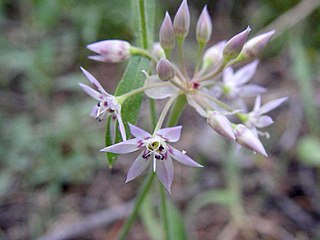
Allium campanulatum is a species of wild onion known by the common name dusky onion or Sierra onion. This is a flowering plant native to the western United States from southeastern Washington and northern Oregon to southern California, and western Nevada. The dusky onion grows in foothills and mountains, especially in dry areas, such as chaparral habitats.
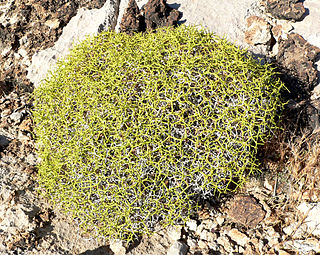
Eriogonum heermannii is a species of wild buckwheat known by the common name Heermann's buckwheat. It is native to the southwestern United States from California to Utah where it grows on rocky slopes, desert flats, and dry washes.

Eschscholzia minutiflora is a species of poppy known by the common name pygmy poppy.
Guillenia flavescens is a species of mustard plant known by the common name yellow mustard, but it is not the only species known by that name. Sinapis alba is probably the plant more widely known as yellow mustard. G. flavescens is a thin-stemmed annual herb growing large, lobed or toothed leaves up to 22 centimeters long around its base, and smaller, less toothed leaves along its gray-pink to brown stem. At intervals along the upper stem appear cream, yellowish, or very pale purple flowers, each somewhat cuboid in shape and about a centimeter long. The tips of the petals around the mouth are curled, flared, or clawlike. The fruit is a thin silique up to 9 centimeters long. This species is endemic to California, where it grows in the valleys and mountains surrounding the San Francisco Bay Area.
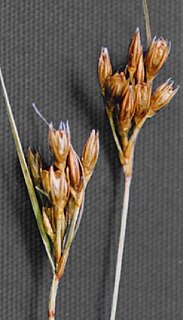
Juncus confusus is a species of rush known by the common name Colorado rush. It is native to western North America from British Columbia to northern California to Colorado, where it grows in coniferous forests and wet, grassy areas such as mountain meadows. It is a bunching rhizomatous perennial herb which grows to a maximum height between 30 and 50 centimeters. Its thready leaves grow from the base of the light green stems to about 15 centimeters long. The inflorescence atop the stem is an array of individual flowers and there is a long bract at the base which may be up to 8 centimeters in length. Each flower has long, pointed tepals with dark and light longitudinal stripes and membranous, translucent borders. There are six stamens. The fruit is a light to dark brown oval-shaped or rounded capsule.
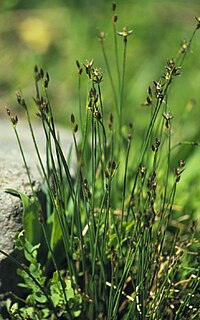
Juncus drummondii is a species of rush known by the common name Drummond's rush. It is native to western North America from northern Canada and Alaska to New Mexico, where it grows in wet coniferous forest and alpine meadows and slopes. This is a perennial herb forming narrow, erect tufts to about 40 centimeters in maximum height. The leaves are basal and most have no real blades; instead they form a sheath around the stem a few centimeters long. The inflorescence is borne on the side of the stem toward the top. There is a long, cylindrical bract at the base which extends out past the flowers. Each flower is on a thin pedicel. The thick tepals are dark brown, sometimes with green striping and thin, transparent edges. There are six stamens with yellowish anthers, and red stigmas. The fruit is a capsule.
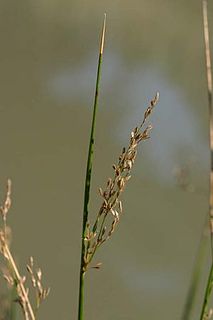
Juncus mexicanus is a species of rush known by the common name Mexican rush. It is native to the southwestern quadrant of the United States and parts of Mexico and Central and South America. It is a plant of moist areas in a great number of habitats, from coast to desert to mountain and low to high elevation.
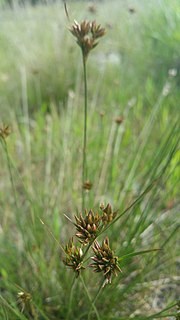
Juncus occidentalis is a species of rush known by the common name western rush. It is native to the western United States, where it grows in wet areas in many types of habitat. This is a bunching perennial herb with thin, stiff stems reaching maximum heights between 30 and 60 centimeters. The wispy leaves grow from the base of the stem and may approach half the stem's length. The inflorescence holds loose bundles of individual flowers and there is usually one long, leaflike bract extending far past the flowers. Each flower has green-striped brownish to reddish tepals each several millimeters long, and six stamens with small anthers. The fruit is a brown capsule which grows encased within the tepals.

Juncus dubius is a species of rush known by the common name wrinkled rush. It is endemic to California, in the California Coast Ranges, Transverse Ranges, and southern Sierra Nevada. It is a common member of the flora in many wet areas, such as marshes and riverbanks.
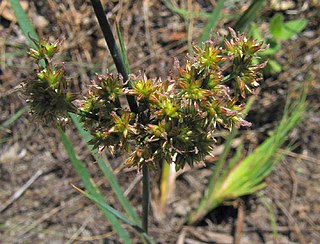
Juncus xiphioides is a species of rush known by the common name irisleaf rush.

Antennaria luzuloides is a North American species of flowering plants in the daisy family known by the common name rush pussytoes. The species is native to western Canada and the western United States.
Juncus bryoides is a species of rush known by the common names moss rush and mosslike dwarf rush. It is native to western North America from Oregon to Baja California, where it grows in many types of wet, sandy habitat. It is a very tiny annual herb producing erect, hair-thin stems no more than about 2 centimeters tall. Atop the stem is one flower made up of a few reddish segments 1 to 3 millimeters long which curve around the developing fruit.
Juncus duranii is an uncommon species of rush known by the common name Duran's rush. It is endemic to southern California, where it is known only from the San Gabriel, San Bernardino, and San Jacinto Mountains.
Juncus hemiendytus is a species of rush known by the common name Herman's dwarf rush. It is native to the western United States, where it grows in moist places, especially areas that are wet in spring, such as vernal pools. This is a very small annual herb forming dense clumps of hair-thin reddish stems no more than about 3 centimeters tall. The tiny, thready leaves surrounding the stems are up to about 2 centimeters long. Each stem usually bears one reddish flower, which is made up of segments 2 or 3 millimeters long curving around the developing fruit.
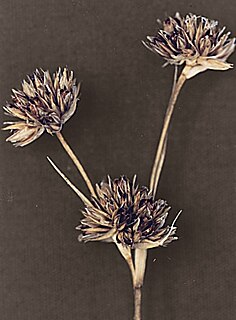
Juncus regelii is a species of rush known by the common name Regel's rush. It is native to western North America from British Columbia to Utah, where it grows in moist mountainous habitat, such as meadows. This is a rhizomatous perennial herb producing a dense clump of flattened stems up to about 60 centimeters tall. The inflorescence is made up of one or more thin or dense clusters of up to 30 flowers each. The flower has narrow, pointed brown to greenish segments.
Juncus tiehmii is a species of rush known by the common name Nevada rush. It is native to the western United States, where it grows in wet habitat with granite sand substrate, including riverbanks and barren seeps. This is a small annual herb forming dense clumps of hair-thin stems no more than about 6 centimeters high. The inflorescence is made up of one to seven tiny flowers atop each stem. The flowers have a few greenish to pink or red segments no more than about 3 millimeters long.
Juncus triformis is an uncommon species of rush known by the common names Yosemite dwarf rush and long-styled dwarf rush.
Juncus uncialis is a species of rush known by the common names twelfth rush and inch-high rush. It is native to the western United States, where it is known from wet habitat such as vernal pools. This is a petite annual herb forming dense clumps of hair-thin green stems no more than 3 or 4 centimeters high. The inflorescence is made up of a single tiny flower atop each stem. The flower has several reddish segments about 2 to 5 millimeters long wrapped around the developing fruit.

Isolepis setacea is a species of flowering plant in the sedge family known by the common names bristle club-rush and bristleleaf bulrush. It is native to Eurasia and Africa, and possibly Australasia. It can be found in other places, including some areas in North America, where it is an introduced species. It grows in many types of moist and wet habitat, often in coastal regions, and sometimes inland. It is a perennial herb which forms mats of very thin, grooved, erect or arching stems up to about 20 centimeters tall. The leaves sheath the stem bases and have short, flat, thick blades. The inflorescence is a solitary spikelet just a few millimeters long, or a cluster of up to three spikelets. These are accompanied by a stiff bract extending past the flowers.
Juncus digitatus is a rare species of rush known by the common name finger rush. It is endemic to Shasta County, California, where it is known from only two occurrences near Shingletown. It occurs in spring-moist habitat such as vernal pools in sunny locations in the foothills of the southernmost Cascade Range. The plant was first collected in 1991 and described to science as a new species in 2008.












